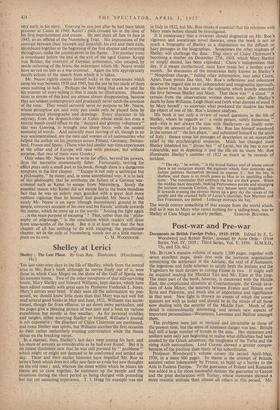Shelley. at Lerici
Shelley : The Last Phase. By Ivan Roe. Illustrated. (Hutchinson. 18s.) THE last sixty-nine days in the life of Shelley, which form the central area in Mr. Roe's book although he moves freely out of it, were those in which Casa Magni on the shore of the Gulf of Spezia was his summer home. Two of the other occupants of that still-surviving house, Mary Shelley and Edward Williams, kept diaries, which have been edited recently with great care by Professor Frederick L. Jones. Mary's entries were brief. If th6y were all the information we pos- sessed, we should know little more than that Mary was not well but read several good books in May and June, 1822. Williams was accus- tomed, though far from effusive, to set down more particulars, and his pages give a pleasing picture of two men and a boat on various expeditions but mostly in fine weather. As for personal troubles and tangles, either worrying Shelley or himself, Williams's journal is not expressive ; the disasters of Claire Clairmont are mentioned, and twice Shelley sees spirits, but Williams ascribes'the first occasion to their rather melancholy evening conversation while the moon shone on the breaking waves.
In a manner, then, Shelley's last days were among his best, and his share of serenity as considerable as he had ever found. But it is no recent disclosure now that, he was still pursued by " problems " which might or might not demand to be confronted and settled any day. These and their earlier histories have impelled 'Mr. Roe to write a book which does not offer new facts as a rule but new thoughts on the old ones ; and, whereas the dates within which he places his theme are so close together, he summons up the people and the situations during the short period as being charged with preceding but not yet unstirring experience. T. J. Hogg for example was not in Italy in 1822, but Mr. Roe thinks it essential that his relations with Mary years before should be investigated.
It is unnecessary that a reviewer should dogmatise on Mr. Roe's vigorous and sometimes novel theories, since the book is not so much a biography of Shelley as a disputation on the difficult or hazy passages in the biographies. Sometimes the other students of Shelley will challenge the data. That story of Claire Clairmont's becoming a mother on December 27th, 1818, which Mary Shelley so simply denied, has been exploded ; Claire's indisposition that day, if it meant motherhood, must have made her a mother every month. So discussion of the mysterious baby known as Shelley's " Neapolitan charge," failing other information, may omit Claire. Apart from points like this, Mr. Roe's reflections and inferences deserve the regard due to an independent and imaginative approach. He shows that in his notes on the infelicity which latterly attended the love between Shelley and Mary. That there was " a cloud " is certain from the observations written down soon after Shelley's death by Jane Williams, Leigh Hunt and (with what distress of mind !) by Mary herself ; to ascertain what produced the shadow has been the object of one of Mr. Roe's keenest analyses.
His book is not only a review of vexed questions in the life of Shelley, whom he regards as " a virile person; subtly humorous " and—this is not always the case with Shelleyans—as finally note- worthy on account of his poems. Mr. Roe has himself wandered in the scenes of " the last phase," and submitted himself to the spirit of Italy ; thence come his passages of description as an acceptable relief to the psychological enquiries. Much has changed since Shelley inhabited his " divine bay " of Lerici,ibut the bay is not so vulnerable, and in depicting it and the life on its shore Mr. Roe illuminates Shelley's summer of 1822 as much as by records of incident.
The sky," he writes, " is the broad Italian roof of whose colour there is no imitation except the pigment which, four centuries ago, Italian painters themselves devised to express it ; but the bay is shallow, and there is as much green as blue in its sparkling reflec- tions. The mountains that embrace the bay are dark green. When the midday. haze descends, making Portovenere purple and smudging the horizon towards Corsica, the very houses seem magnified.. - If towards evening the sirocco blows up a grey sky the voices of the people and the cracked bells of Lerici's churches, San Martino and San Francesco, are muted. Lethargy enwraps the bay."
The words convey something 'of that escape from the world which, dull as it was to Mary who cared nothing for a sailing-boat, was to Shelley at Casa Magni so nearly perfect. EDMUND BLUNDEN.


































 Previous page
Previous page